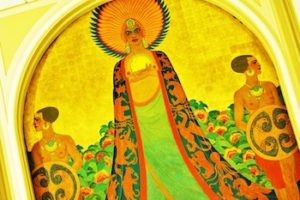
Queen Califa mural, San Francisco
*The creation of the name California is celebrated on this date in 1850, the official date of its statehood. The designation “California” is another piece of African American history.
The name is derived from a knightly romance book published in 1510. The story was about an island paradise near the Indies where a beautiful Black Queen, Califia, ruled. She led a country of Black Amazons with masses of pearls and gold. To help perpetuate the race, men were only allowed in Califia one day a year.
The Spanish explorer Cortez and his men thought they had found the island in 1535 because they had found pearls. Later, Francisco de Ulloa found that the island was really the Baja Peninsula. Califia's life and land "at the right hand of the Indies" were described in a novel written around 1510 by Garcia Ordonez Rodriguez de Montalvo, a Spanish writer, entitled "Las Sergas de Esplandian." This document, to some extent, helped precipitate the Spanish hunt for gold in North America.
Thirty years later, when the explorer Cortés landed with his crew in what is known today as Baja California, it is said that he announced to his men (of whom many were African) that they had arrived in Califia's land. When the Spanish began exploring the Pacific coast, they applied this name to their maps to what is now known as the Baja Peninsula, which they initially believed was an island. Once the name was on the maps, it stuck. Seville, Spain, published the following statement in the early 16th Century.
Sabes que a la diestra mano de las Indias existe una isla llamada California muy cerca de un costado del Paraíso Terrenal; y estaba poblada por mujeres negras, sin que existiera allí un hombre, pues vivían a la manera de las amazonas. Eran de bellos y robustos cuerpos, fogosos valores y gran fuerza. Su isla era la más fuerte de todo el mundo, con sus escarpados farallones y sus pétreas costas. Sus armas eran todas de oro y del mismo metal eran los arneses de las bestias salvajes que ellas acostumbraban domar para montarlas, porque en toda la isla no había otro metal que el oro.
Know that on the right hand of the Indies exists an island called California, which is very close to a side of the Earthly Paradise, and black women populated it, without any man existing there because they lived in the way of the Amazons. They had beautiful and robust bodies and were brave and very strong. Their island was the strongest in the World, with its cliffs and rocky shores. Their weapons were golden, and so were the harnesses of the wild beasts that they were accustomed to domesticating and riding, because there was no other metal on the island than gold. Las Sergas de Esplandián, (novela de caballería) by García Ordóñez de Montalvo. Published in Seville in 1510.

By 1770, the Pacific coast controlled by Spain had been named California, and the Spanish-speaking people who lived there were called Californios. Edward Everett Hale, for The Antiquarian Society, translated a portion of the original of this document, and the story was printed in the Atlantic Monthly magazine in 1864.
The best-known depictions of Queen Califia are murals done by famous artists. One seven-foot-high panel showing Califia as a Black woman with her Amazons is in The Room of the Dons at the Mark Hopkins Intercontinental Hotel in San Francisco and was created for the hotel's opening in 1926 by Maynard Dixon and Frank Von Sloun. Another famous depiction, created by Louise Lloyd and entitled "The Naming of California," can be seen in Sacramento in the Senate Rules Committee Hearing Chamber on the 4th floor of the State Building (and in this article).